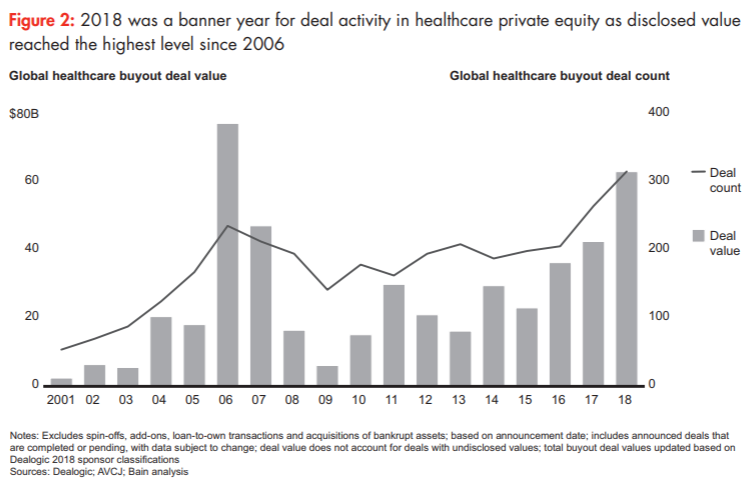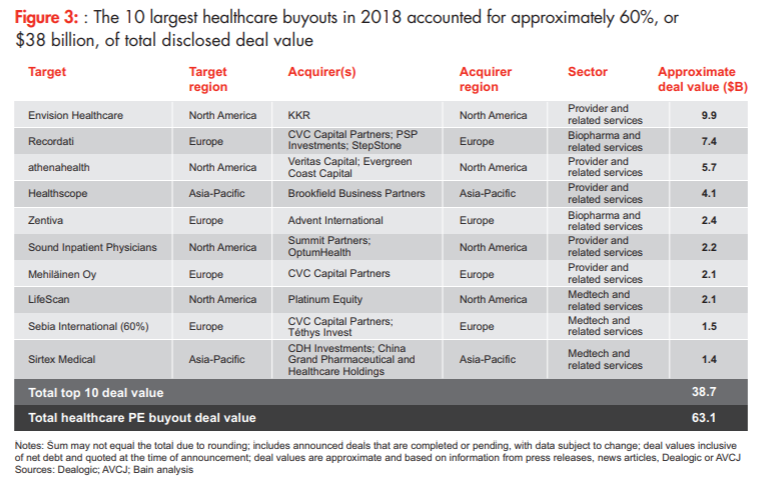Bain & Co released a Healthcare Private Equity and Corporate M&A Report 2019 here. (1.7Mb, 64 pages) First blog post on the private equity half.
Bain & Company notes that “there was significant activity across all segments of the value chain.” Whoa, all segments? Yep – provider, pharma, IT, behavioral health, dental, vet, concierge, hospice, and clinical labs. . .
Business was great in 2018. Period.
2018 PE Healthcare: $63 Billion, up 50% YoY
Healthcare PE values grew almost 50% to $63.1 billion (316 deals) in 2018, vs the $42.6 billion (265 deals) in 2017. This compares favorably to the overall PE market – which was also good – but only grew 11% YoY to $447 Billion. As in previous years, there is a lot of cash looking for a home.
Valuations are not cheap, yet the healthcare deal value (grey bars below) was the highest its been since 2006. Investors see healthcare as a potential safe-haven during any potential recession. Also, US healthcare is woefully inefficient because of fragmentation and erratic regulation. It’s ripe for what private equity does best – find ways to raise EBITDA.

Top 10 deals = 60% of deal volume
The 80/20 principle is alive at well here. The following deals shown below accounted for 60% of total volume. The largest was KKR’s acquisition of Envision Healthcare, in the physician practice management (PPM) space.

Crowded Market = More Partnering
After 9+ years of cheap money, a lot of the promising, smaller deals have been snapped up. The more expensive, larger businesses remain.
As a result, funds have been partnering with financial (other funds) and strategic buyers (companies operating in healthcare). They may want to diminish the risk or tap into operational know-how to unlock synergies (fancy talk for increasing EBITDA). In fact, Bain reports that 7 of the 18 deals > $1 billion were led by financial consortiums.
Crowded Market = Taking Public Companies Private
Funds are increasingly buying shares on the public market, and taking public firms private. As a quick finviz.com exercise, there are 21 companies with positive net margins, trading with a <20 P/E multiple, <$2B market cap.

Let’s pause a moment here. Competition for quality assets is so fierce that funds are looking at public companies. . . yes, competition is driving up willingness to pay.
Crowded Market = Buy and Build
Bolt on acquisitions. This has been a trend for several years, but PE firms are acting like strategic buyers and actively creating value; the days of wait-and-hold for rising valuations are gone. Humana (with 2 PE firms) bought Curo Health Services in 2018 for $1.4B to bolt-on to their prior acquisition of Kindred Healthcare in 2017 for $4.1B. If the investment thesis made sense in December (all things being equal), it should make sense in April too.
Other examples include:
- Nordic Capital buys 3 dental groups and large dental laboratory across Germany, Switzerland, and Netherlands
- Bain Capital’s revenue-cycle platform (Waystar) is comprised of 3 acquisitions: Navicure in 2016, Zirmed in 2017, and Connance in 2018
- VetCor Professional Practices grew from 41 locations (2010) to 270 locations (2018) in 28 states
Funds can improve their chances of success by ensuring that the initial platform has a stable core on which to build, putting a capable management team in place to drive growth from acquisitions, and buying add-ons that can lead to category or regional scale without losing sight of both revenue- and cost-based synergies.
Bain & Company
It’s encouraging to see PE funds (and their strategic partners) take a longer-view and build businesses. The US healthcare value chain is super fragmented and consolidation leading to economies of scale is welcome.
Provider and related services = 55% of total deals
As you can see from the red color bars below, providers and related services are consistently the largest deal segment. For the US, this makes sense as hospitals makes up 50% of total healthcare, and labor cost is 50% of that spend. There is massive consolidation and many clinicians are opting for employment, instead of private practices. Less investment, less IT burden, less liability, less headache.

- KKR acquired Envision Healthcare for $9.9 billion; 30,000 clinicians across 900 hospitals. They reviewed 25 proposals and chose KKR
- Summit Partners–led group teamed with OptumHealth to acquire a controlling stake in Sound Inpatient Physicians for $2.2 billion
- Silver Oak Service Partners bought Integrated Oncology Network.
- Windrose Health Investors acquired Traditions Behavioral Health
- Carlyle invested $350 million in One Medical, a technology-enabled primary care model (read: concierge care)
- Veritas Capital Management / Elliott Management’s Evergreen Coast Capital to take athenahealth private for $5.7 billion
Fee-for-Service (Eventually)
US healthcare is a labyrinth of payers, charge codes, reimbursements, and incentives. It is still primarily fee-for-service (read: get paid by volume). Yes, this is changing slowly. Payment structures are evolving – slowly – to incentivize outcomes, not volume of tests / procedures / consults.
For me, it’s fascinating that PE firms and investors are not shying away form reimbursement risk. It’s massively uncertain (think: Obama – Trump), but that is part of the risk arbitrage that creates alpha. Perhaps it is the hedging approach – see below – that makes this risk palatable.
Amid the gradual shift in payment models and the disconnect between physicians and healthcare provider administrators, investors should seek assets that will perform well in a fee-for-service world yet also have the capabilities to move to a fee-for-value model.
Bain & Company
BioPharma buyouts of $16.5B in 2018, near record levels
There were 79 deals in 2018, but two of them Recordati (Italian pharma, $7.4B) and Zentiva (generics, $2.4B) made up 60% of the deal value. In the US, there has been a lot of regulatory and political talk about pricing, but in Jan 2019 hundreds of drug prices increased to make up the difference. Multiple PE firms are raising biopharma funds:
- Bain Capital raised a $720M life sciences fund
- Blackstone acquired Clarus, a life sciences investment fund with $2.6B assets under management
- TPG has a VC Biotech arm with $550M assets under management
MedTech deals total $10.5B, up 50% YoY
There were 67 deals in medical devices in 2018, with 5 of them over $1B. J&J carved out some of their non-core assets: Advanced Sterilization Products ($2.4B), and Lifescan glucose monitoring ($1.2B). Two other large deals included Sirtex radioactive crystals used in oncology ($1.4B) and Analogic imaging devices ($1.1B). A few factors driving deals include:
- Niche category leadership (read: small, protected, and profitable)
- Cost containment and sales force effectiveness (read: run better)
- Increased contract manufacturing (read: no factory needed)
- Need for specialty distribution (read: no dedicated sales force)
- Direct-to-consumer (e.g., SmileDirectClub)
Healthcare IT deals totaled $8.6B in 2018
This deal flow has been pretty erratic during the last 3 years:
- $15.5B in 2016
- $ 1.9B in 2017
- $ 8.6B in 2018 (2 deals make up 80% of total)
2018 was clearly driven by large deals. Vertias Capital Partners bought GE Healthcare for $1.1B and Athena Health for $5.7B. Their thesis: combing the RCM (Revenue cycle management) and EMR (Electronic medical records) pieces under the AthenaHealth brand.
Healthcare IT: Profitable niches today
When I was in hospital consulting for 5-6 years, this is what I saw. Health systems with hundred+ siloed information systems, not talking with each other. “Catch up to the regulation” post-mortem approach to compliance, measurement, and often times, paperwork. There is a lot of money to be made solving specific problems. Some PE examples from 2018:
- Netsmart Technologies – connects behavioral health, social services, and post-acute records (AllScript’s stake acquired for $525M)
- Alphabet-backed Flatiron acquired by Roche or $1.9B; oncology focused EMR, linked to 250 community oncology practices
Healthcare IT: Interoperability tomorrow
Healthcare has a data problem. Not for a lack of data. No, there is plenty of data. The problem is that data is fragmented, poorly structured, inconsistent, sporadic, poorly defined, and siloed. The data does not talk to each other. It’s a universe of “vlook-up” on excel. Yikes.
Yes, interoperability – among systems, among locations, among data types – seems like a bit of a pipe dream currently, but it’s step 1 for real clinical decision support, patient-level accountability to wellness, activity-based costing of the true cost of care, and ultimately, tracking the correlation between diagnosis, treatment, and outcomes. Yes, scientific method.
- HgCapital acquired Orion Health’s Rhapsody business. One this video they say “simple and seamless integration of all health data.” That’s some pretty big talk . .
- Google though its “cloud healthcare application programming interface solution” and Amazon Web Services are looking to breakdown barriers for interoperability
Unsurprisingly, there is lots of venture capital (VC) funding new businesses in the area of data analytics (KKR $57M for Clarify Health Solutions series B), and telemedicine (Allianz/Philips $425M – American Well). We’ll cover that in the 2nd half of the Bain report. . next post.
Related posts:
